Benjamin Eysenbach
Shane
Multistep Quasimetric Learning for Scalable Goal-conditioned Reinforcement Learning
Nov 14, 2025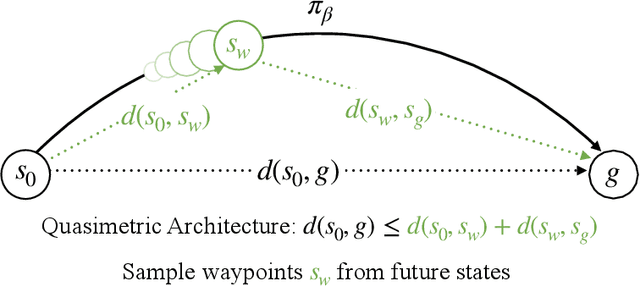

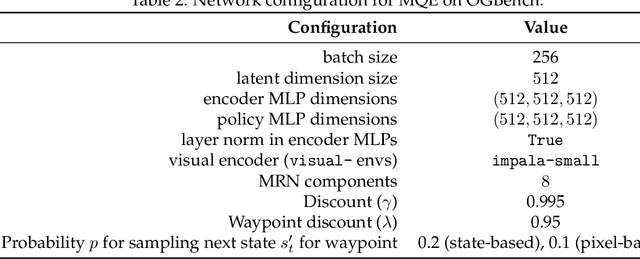
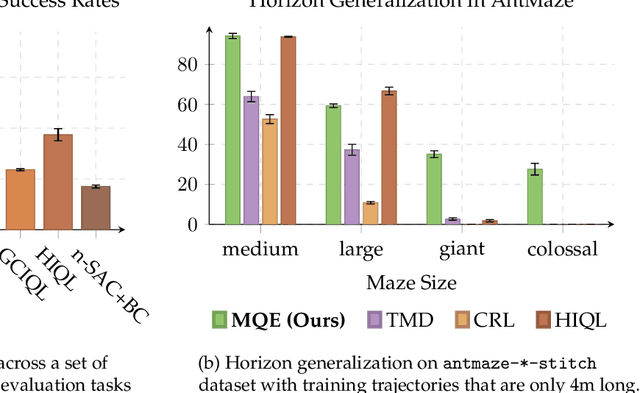
Abstract:Learning how to reach goals in an environment is a longstanding challenge in AI, yet reasoning over long horizons remains a challenge for modern methods. The key question is how to estimate the temporal distance between pairs of observations. While temporal difference methods leverage local updates to provide optimality guarantees, they often perform worse than Monte Carlo methods that perform global updates (e.g., with multi-step returns), which lack such guarantees. We show how these approaches can be integrated into a practical GCRL method that fits a quasimetric distance using a multistep Monte-Carlo return. We show our method outperforms existing GCRL methods on long-horizon simulated tasks with up to 4000 steps, even with visual observations. We also demonstrate that our method can enable stitching in the real-world robotic manipulation domain (Bridge setup). Our approach is the first end-to-end GCRL method that enables multistep stitching in this real-world manipulation domain from an unlabeled offline dataset of visual observations.
Demystifying the Mechanisms Behind Emergent Exploration in Goal-conditioned RL
Oct 15, 2025Abstract:In this work, we take a first step toward elucidating the mechanisms behind emergent exploration in unsupervised reinforcement learning. We study Single-Goal Contrastive Reinforcement Learning (SGCRL), a self-supervised algorithm capable of solving challenging long-horizon goal-reaching tasks without external rewards or curricula. We combine theoretical analysis of the algorithm's objective function with controlled experiments to understand what drives its exploration. We show that SGCRL maximizes implicit rewards shaped by its learned representations. These representations automatically modify the reward landscape to promote exploration before reaching the goal and exploitation thereafter. Our experiments also demonstrate that these exploration dynamics arise from learning low-rank representations of the state space rather than from neural network function approximation. Our improved understanding enables us to adapt SGCRL to perform safety-aware exploration.
Intention-Conditioned Flow Occupancy Models
Jun 10, 2025Abstract:Large-scale pre-training has fundamentally changed how machine learning research is done today: large foundation models are trained once, and then can be used by anyone in the community (including those without data or compute resources to train a model from scratch) to adapt and fine-tune to specific tasks. Applying this same framework to reinforcement learning (RL) is appealing because it offers compelling avenues for addressing core challenges in RL, including sample efficiency and robustness. However, there remains a fundamental challenge to pre-train large models in the context of RL: actions have long-term dependencies, so training a foundation model that reasons across time is important. Recent advances in generative AI have provided new tools for modeling highly complex distributions. In this paper, we build a probabilistic model to predict which states an agent will visit in the temporally distant future (i.e., an occupancy measure) using flow matching. As large datasets are often constructed by many distinct users performing distinct tasks, we include in our model a latent variable capturing the user intention. This intention increases the expressivity of our model, and enables adaptation with generalized policy improvement. We call our proposed method intention-conditioned flow occupancy models (InFOM). Comparing with alternative methods for pre-training, our experiments on $36$ state-based and $4$ image-based benchmark tasks demonstrate that the proposed method achieves $1.8 \times$ median improvement in returns and increases success rates by $36\%$. Website: https://chongyi-zheng.github.io/infom Code: https://github.com/chongyi-zheng/infom
Horizon Reduction Makes RL Scalable
Jun 08, 2025
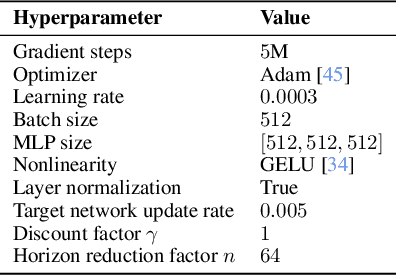
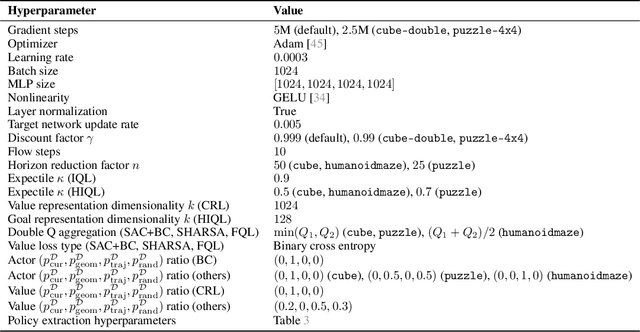
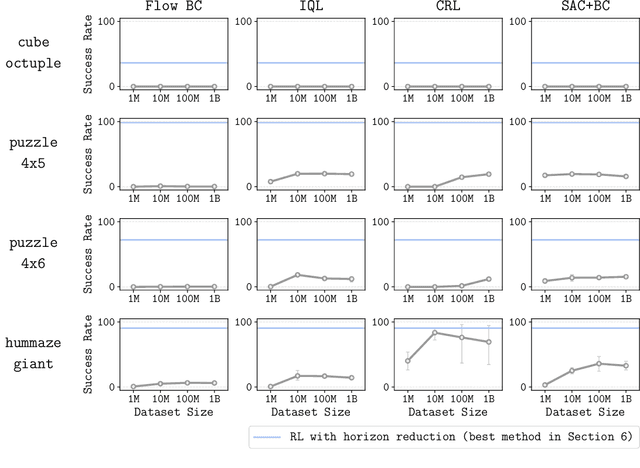
Abstract:In this work, we study the scalability of offline reinforcement learning (RL) algorithms. In principle, a truly scalable offline RL algorithm should be able to solve any given problem, regardless of its complexity, given sufficient data, compute, and model capacity. We investigate if and how current offline RL algorithms match up to this promise on diverse, challenging, previously unsolved tasks, using datasets up to 1000x larger than typical offline RL datasets. We observe that despite scaling up data, many existing offline RL algorithms exhibit poor scaling behavior, saturating well below the maximum performance. We hypothesize that the horizon is the main cause behind the poor scaling of offline RL. We empirically verify this hypothesis through several analysis experiments, showing that long horizons indeed present a fundamental barrier to scaling up offline RL. We then show that various horizon reduction techniques substantially enhance scalability on challenging tasks. Based on our insights, we also introduce a minimal yet scalable method named SHARSA that effectively reduces the horizon. SHARSA achieves the best asymptotic performance and scaling behavior among our evaluation methods, showing that explicitly reducing the horizon unlocks the scalability of offline RL. Code: https://github.com/seohongpark/horizon-reduction
Normalizing Flows are Capable Models for RL
May 29, 2025Abstract:Modern reinforcement learning (RL) algorithms have found success by using powerful probabilistic models, such as transformers, energy-based models, and diffusion/flow-based models. To this end, RL researchers often choose to pay the price of accommodating these models into their algorithms -- diffusion models are expressive, but are computationally intensive due to their reliance on solving differential equations, while autoregressive transformer models are scalable but typically require learning discrete representations. Normalizing flows (NFs), by contrast, seem to provide an appealing alternative, as they enable likelihoods and sampling without solving differential equations or autoregressive architectures. However, their potential in RL has received limited attention, partly due to the prevailing belief that normalizing flows lack sufficient expressivity. We show that this is not the case. Building on recent work in NFs, we propose a single NF architecture which integrates seamlessly into RL algorithms, serving as a policy, Q-function, and occupancy measure. Our approach leads to much simpler algorithms, and achieves higher performance in imitation learning, offline, goal conditioned RL and unsupervised RL.
1000 Layer Networks for Self-Supervised RL: Scaling Depth Can Enable New Goal-Reaching Capabilities
Mar 19, 2025Abstract:Scaling up self-supervised learning has driven breakthroughs in language and vision, yet comparable progress has remained elusive in reinforcement learning (RL). In this paper, we study building blocks for self-supervised RL that unlock substantial improvements in scalability, with network depth serving as a critical factor. Whereas most RL papers in recent years have relied on shallow architectures (around 2 - 5 layers), we demonstrate that increasing the depth up to 1024 layers can significantly boost performance. Our experiments are conducted in an unsupervised goal-conditioned setting, where no demonstrations or rewards are provided, so an agent must explore (from scratch) and learn how to maximize the likelihood of reaching commanded goals. Evaluated on simulated locomotion and manipulation tasks, our approach increases performance by $2\times$ - $50\times$. Increasing the model depth not only increases success rates but also qualitatively changes the behaviors learned.
The "Law" of the Unconscious Contrastive Learner: Probabilistic Alignment of Unpaired Modalities
Jan 20, 2025



Abstract:While internet-scale data often comes in pairs (e.g., audio/image, image/text), we often want to perform inferences over modalities unseen together in the training data (e.g., audio/text). Empirically, this can often be addressed by learning multiple contrastive embedding spaces between existing modality pairs, implicitly hoping that unseen modality pairs will end up being aligned. This theoretical paper proves that this hope is well founded, under certain assumptions. Starting with the proper Bayesian approach of integrating out intermediate modalities, we show that directly comparing the representations of data from unpaired modalities can recover the same likelihood ratio. Our analysis builds on prior work on the geometry and probabilistic interpretation of contrastive representations, showing how these representations can answer many of the same inferences as probabilistic graphical models. Our analysis suggests two new ways of using contrastive representations: in settings with pre-trained contrastive models, and for handling language ambiguity in reinforcement learning. Our numerical experiments study the importance of our assumptions and demonstrate these new applications.
Horizon Generalization in Reinforcement Learning
Jan 06, 2025



Abstract:We study goal-conditioned RL through the lens of generalization, but not in the traditional sense of random augmentations and domain randomization. Rather, we aim to learn goal-directed policies that generalize with respect to the horizon: after training to reach nearby goals (which are easy to learn), these policies should succeed in reaching distant goals (which are quite challenging to learn). In the same way that invariance is closely linked with generalization is other areas of machine learning (e.g., normalization layers make a network invariant to scale, and therefore generalize to inputs of varying scales), we show that this notion of horizon generalization is closely linked with invariance to planning: a policy navigating towards a goal will select the same actions as if it were navigating to a waypoint en route to that goal. Thus, such a policy trained to reach nearby goals should succeed at reaching arbitrarily-distant goals. Our theoretical analysis proves that both horizon generalization and planning invariance are possible, under some assumptions. We present new experimental results and recall findings from prior work in support of our theoretical results. Taken together, our results open the door to studying how techniques for invariance and generalization developed in other areas of machine learning might be adapted to achieve this alluring property.
Can a MISL Fly? Analysis and Ingredients for Mutual Information Skill Learning
Dec 11, 2024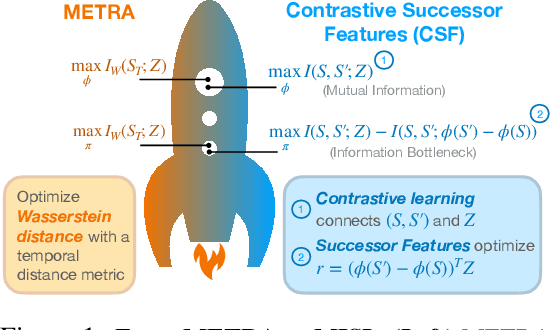
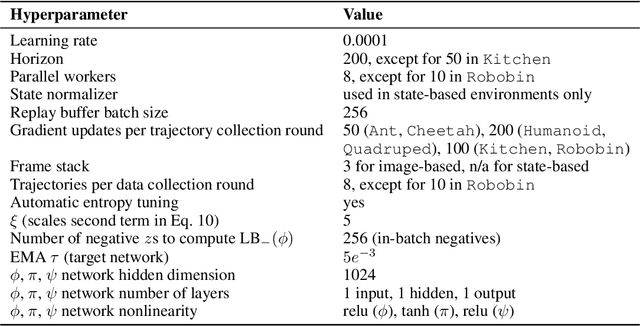
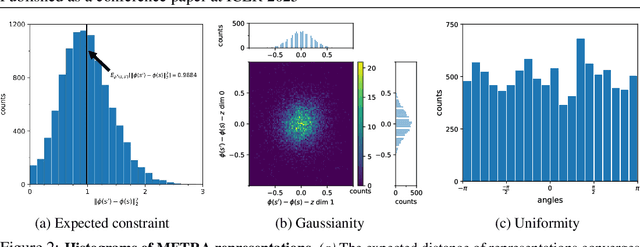

Abstract:Self-supervised learning has the potential of lifting several of the key challenges in reinforcement learning today, such as exploration, representation learning, and reward design. Recent work (METRA) has effectively argued that moving away from mutual information and instead optimizing a certain Wasserstein distance is important for good performance. In this paper, we argue that the benefits seen in that paper can largely be explained within the existing framework of mutual information skill learning (MISL). Our analysis suggests a new MISL method (contrastive successor features) that retains the excellent performance of METRA with fewer moving parts, and highlights connections between skill learning, contrastive representation learning, and successor features. Finally, through careful ablation studies, we provide further insight into some of the key ingredients for both our method and METRA.
Learning to Assist Humans without Inferring Rewards
Nov 04, 2024Abstract:Assistive agents should make humans' lives easier. Classically, such assistance is studied through the lens of inverse reinforcement learning, where an assistive agent (e.g., a chatbot, a robot) infers a human's intention and then selects actions to help the human reach that goal. This approach requires inferring intentions, which can be difficult in high-dimensional settings. We build upon prior work that studies assistance through the lens of empowerment: an assistive agent aims to maximize the influence of the human's actions such that they exert a greater control over the environmental outcomes and can solve tasks in fewer steps. We lift the major limitation of prior work in this area--scalability to high-dimensional settings--with contrastive successor representations. We formally prove that these representations estimate a similar notion of empowerment to that studied by prior work and provide a ready-made mechanism for optimizing it. Empirically, our proposed method outperforms prior methods on synthetic benchmarks, and scales to Overcooked, a cooperative game setting. Theoretically, our work connects ideas from information theory, neuroscience, and reinforcement learning, and charts a path for representations to play a critical role in solving assistive problems.
 Add to Chrome
Add to Chrome Add to Firefox
Add to Firefox Add to Edge
Add to Edge